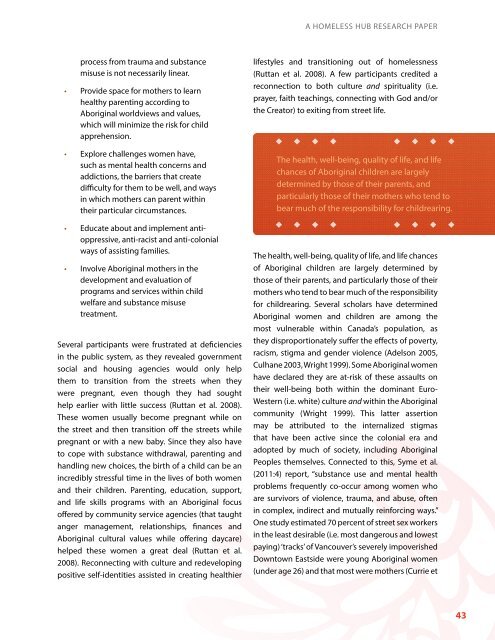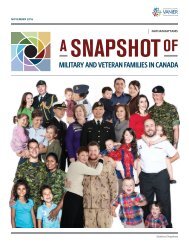1ee0ey1
1ee0ey1
1ee0ey1
You also want an ePaper? Increase the reach of your titles
YUMPU automatically turns print PDFs into web optimized ePapers that Google loves.
A HOMELESS HUB RESEARCH PAPER<br />
process from trauma and substance<br />
misuse is not necessarily linear.<br />
• Provide space for mothers to learn<br />
healthy parenting according to<br />
Aboriginal worldviews and values,<br />
which will minimize the risk for child<br />
apprehension.<br />
• Explore challenges women have,<br />
such as mental health concerns and<br />
addictions, the barriers that create<br />
difficulty for them to be well, and ways<br />
in which mothers can parent within<br />
their particular circumstances.<br />
• Educate about and implement antioppressive,<br />
anti-racist and anti-colonial<br />
ways of assisting families.<br />
• Involve Aboriginal mothers in the<br />
development and evaluation of<br />
programs and services within child<br />
welfare and substance misuse<br />
treatment.<br />
Several participants were frustrated at deficiencies<br />
in the public system, as they revealed government<br />
social and housing agencies would only help<br />
them to transition from the streets when they<br />
were pregnant, even though they had sought<br />
help earlier with little success (Ruttan et al. 2008).<br />
These women usually become pregnant while on<br />
the street and then transition off the streets while<br />
pregnant or with a new baby. Since they also have<br />
to cope with substance withdrawal, parenting and<br />
handling new choices, the birth of a child can be an<br />
incredibly stressful time in the lives of both women<br />
and their children. Parenting, education, support,<br />
and life skills programs with an Aboriginal focus<br />
offered by community service agencies (that taught<br />
anger management, relationships, finances and<br />
Aboriginal cultural values while offering daycare)<br />
helped these women a great deal (Ruttan et al.<br />
2008). Reconnecting with culture and redeveloping<br />
positive self-identities assisted in creating healthier<br />
lifestyles and transitioning out of homelessness<br />
(Ruttan et al. 2008). A few participants credited a<br />
reconnection to both culture and spirituality (i.e.<br />
prayer, faith teachings, connecting with God and/or<br />
the Creator) to exiting from street life.<br />
The health, well-being, quality of life, and life<br />
chances of Aboriginal children are largely<br />
determined by those of their parents, and<br />
particularly those of their mothers who tend to<br />
bear much of the responsibility for childrearing.<br />
The health, well-being, quality of life, and life chances<br />
of Aboriginal children are largely determined by<br />
those of their parents, and particularly those of their<br />
mothers who tend to bear much of the responsibility<br />
for childrearing. Several scholars have determined<br />
Aboriginal women and children are among the<br />
most vulnerable within Canada’s population, as<br />
they disproportionately suffer the effects of poverty,<br />
racism, stigma and gender violence (Adelson 2005,<br />
Culhane 2003, Wright 1999). Some Aboriginal women<br />
have declared they are at-risk of these assaults on<br />
their well-being both within the dominant Euro-<br />
Western (i.e. white) culture and within the Aboriginal<br />
community (Wright 1999). This latter assertion<br />
may be attributed to the internalized stigmas<br />
that have been active since the colonial era and<br />
adopted by much of society, including Aboriginal<br />
Peoples themselves. Connected to this, Syme et al.<br />
(2011:4) report, “substance use and mental health<br />
problems frequently co-occur among women who<br />
are survivors of violence, trauma, and abuse, often<br />
in complex, indirect and mutually reinforcing ways.”<br />
One study estimated 70 percent of street sex workers<br />
in the least desirable (i.e. most dangerous and lowest<br />
paying) ‘tracks’ of Vancouver’s severely impoverished<br />
Downtown Eastside were young Aboriginal women<br />
(under age 26) and that most were mothers (Currie et<br />
43





